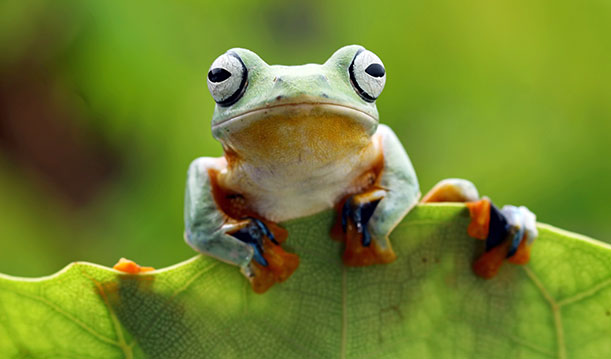BOOMbox at Home: Amphibian Activities
August 11, 2020

Amphibians are cold-blooded vertebrates that live part of their lives in water and part on land. Toads, frogs, salamanders, newts, and caecilians are all amphibians. Try the following activities to learn more about these curious creatures.
Life cycle
One of the remarkable things about amphibians is how drastically their bodies change as they grow. Recreate the stages of development of a frog using clay. Gather clay, play dough, or another malleable material and recreate the frog life cycle from egg to tadpole to frog. For an additional challenge, try to make your model more realistic by basing it on a specific species of frog. If you don’t have play dough, consider making your own!
Interesting adaptations
One feature that sets amphibians apart from other types of vertebrates is their extremely permeable skin. This skin makes it easier for amphibians to breathe and to absorb water in dry environments. Unfortunately, it also makes them more susceptible to dangerous chemicals and other pollutants. Want to see just how much permeable skin can soak up? The Association of Zoos and Aquariums created an activity using eggs and food coloring to model amphibian skin.
Once you start thinking about how important absorbing water is for some amphibians, you may start to wonder how they manage changes in weather. What do they do when most of the water around them is frozen, or when they’re in a place with little rain? Follow a basic demonstration to learn why frogs don’t freeze, using only syrup and water! To learn more, read about how frogs survive winter, including details on hibernation as well as estivation, a strategy some amphibians use to beat the heat.
Ideal environments
Clay frogs aren’t just for kids. In nature, frogs come in a wide range of colors, from those that blend in to those that stand out. Dull colors can help frogs hide from predators, but bright colors can offer a warning that the animal is poisonous and is not a very tasty treat! Read an article about researchers who used clay frogs to observe which colors offered the most protection from predators without endangering any live animals. Then, make some clay frogs of your own with a no-bake play dough recipe using salt, flour, oil, and water. Imagine what sorts of experiments your creations could be used for!
Now that you’ve started thinking about how an amphibian’s color is related to its environment, use a database such as Amphibia Web to explore the many colorful amphibians that have been observed in nature around the world. As you conduct your search, take note of the scientific names of any that stand out to you in particular. Try to find three that are native to different climate conditions. With these three, draw a color-coded heat map of their native habitats across the globe. Here’s a blank map you can use to get started.
Finally, imagine and draw an amphibian utopia for one species you selected. What would be the dream landscape for this amphibian? Consider the amphibian’s diet, climate, shelter, and potential predators. If this amphibian were to truly thrive, what would its surroundings look like? Alternatively, pick an environment, and try to design its ideal amphibian. Explain what characteristics would make your imaginary amphibian perfect for that place.
Scientist of the Week
Maya Master is a herpetologist (a zoologist who specializes in reptiles and amphibians) who studies biology, climate change, and policy. She discusses her pathway into the field and offers advice to others who are interested in conservation science. Her instagram account regularly showcases the realities of her experience as a woman of color in STEM.
Share
We’d love to see the results of your experiments! Tag @skokielibrary when you share photos of what you’ve created on social media.
Written by Eli and Ladipo.